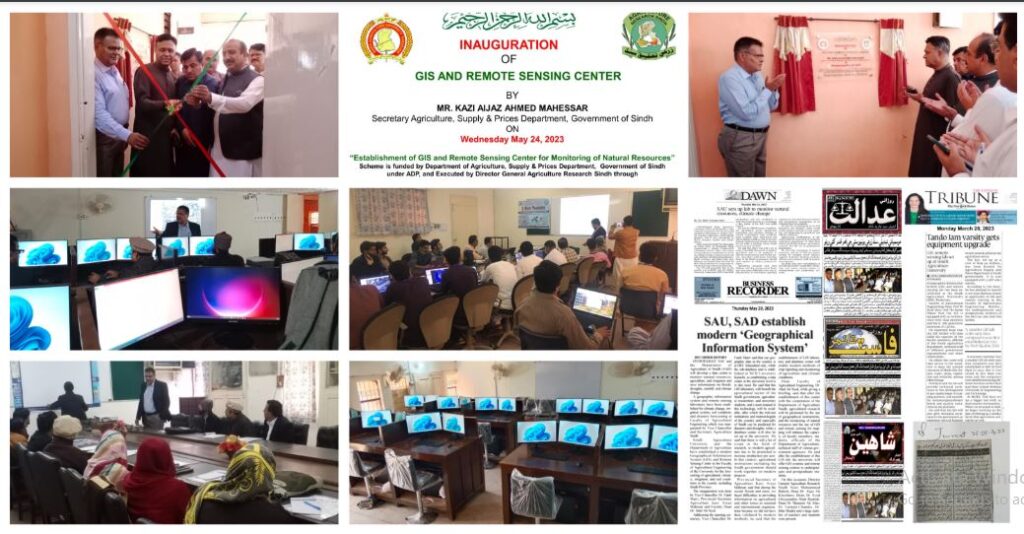GIS AND REMOTE SENSING CENTER (GRC)
The GIS and Remote Sensing Center (GRC) is located within the Faculty of Agricultural Engineering at Sindh Agricultural University (SAU), Tandojam, Pakistan. It serves as a cutting-edge facility for GIS and remote sensing technologies. Officially inaugurated on May 24, 2023, by Mr. Kazi Aijaz Ahmed Mahessar, Secretary of Agriculture, Supply & Prices Department, Government of Sindh, the event was attended by Dr. Fateh Muhammad Marri, Vice Chancellor of SAU; Mr. Noor Muhammad Baloch, Director General of Agricultural Research Sindh; and Dr. Altaf Ali Siyal, Dean of the Faculty of Agricultural Engineering. The establishment of GRC marks a significant advancement in incorporating technology for the sustainable management of natural resources. Equipped with state-of-the-art technological tools and sustainable energy sources, the Center serves as a leading hub for GIS and remote sensing advancements in Pakistan.
About the Center:
The center was established to provide high-quality geospatial education and conduct research that empowers students, researchers, and policymakers. It is equipped with advanced technological infrastructure, including dual LCD monitor desktop PCs, GPS receivers, GIS and remote sensing software, and sustainable power solutions powered by a solar system. Offering both undergraduate and postgraduate courses in GIS and remote sensing, the Center ensures that the future workforce is proficient in utilizing these technologies for agricultural development. Having already completed district-wise land use and land cover classification mapping, the Center furnishes valuable data for informed decision-making at various administrative levels. The lab, established at a cost of Rs. 11.54 million, has been funded by the Agriculture Supply and Prices Department, Government of Sindh. The GRC is equipped with a 5KV solar system.
The GIS and RS Center has achieved a significant milestone by successfully completing district-wise land use and land cover classification mapping for the year 2022 through ground truthing and satellite data validation. This accomplishment aligns with the Center’s initial objectives, furnishing researchers and policymakers with crucial data to facilitate informed decision-making in administrative and agricultural domains. Furthermore, the Center has emerged as a trusted collaborator by providing proficient technical support to government agencies, particularly in addressing the challenges posed by floods, droughts, pests, and locusts amidst the prevailing climate change scenario in Sindh Province.
Research Activities:
• Land Use and Land Cover Classification
• Natural Hazard (Floods, Droughts, Cyclones, etc.) Monitoring and Mapping
• Agricultural Resource Monitoring, Mapping and Management
• Forest Mapping & Carbon Sequestration
• Capacity Building of students and Government officials in use of Remote sensing and geospatial tools
Project Team:
1. Prof. Dr. Altaf Ali Siyal
Project Director
Dean, Faculty of Agricultural Engineering, SAU, Tandojam
2. Dr. Muhammad Sohail Memon
Project GIS Specialist
Lecturer, Faculty of Agricultural Engineering, SAU, Tandojam
Training Program
GIS and RS Center (GRC) provides various training programs for the capacity building of professionals and students. Here’s a detailed overview of the three training workshops, organized by their respective themes:
Training #1:
GIS and Remote Sensing Application Training Workshop (March 8-10, 2022)
A comprehensive three-day workshop aimed to build technical proficiency among graduate and postgraduate students in GIS and Remote Sensing through practical learning. Key areas covered:
Field Data Collection: Participants learned to conduct georeferenced surveys and collect spatial data using GPS. They practised determining the length and altitude of canals, minors, and watercourses while also measuring the area of agricultural lands and water reservoirs.
Geospatial Data Visualization: The workshop focused on creating kml/kmz and shapefiles, visualizing data through Google Earth, and digitizing irrigation network maps. This practical exercise allowed participants to gain hands-on experience in managing data.
Analysis and Mapping: Students developed crop and water masks for specific areas, conducted land use and land cover (LULC) classifications using both unsupervised and supervised classification methods, and created thematic maps to analyze agricultural data.
Training #2:
Introduction to GIS and Its Application (January 24-25, 2024)
This two-day workshop provided a foundational understanding of GIS and its application to Agricultural Research officers and Postgraduate Students. It covered:
Introduction to GIS and Remote Sensing: Participants were introduced to basic concepts of GIS, RS, and their various applications across different sectors.
GPS Data Collection: Training included collecting field data and visualizing it via Google Earth to better understand geographic information.
Map Digitization and Spatial Analysis: The training incorporated vector data creation, map digitization, georeferencing satellite images, developing irrigation network maps, and creating thematic maps using GIS software.
Training #3:
GIS & Remote Sensing Applications in Agriculture (February 13-15, 2024)
Focusing on GIS and remote sensing applications in agriculture, this three-day workshop trained students and professionals in efficiently monitoring and managing natural resources. Participants gained hands-on experience, including: Advanced Geospatial Tools: Attendees worked with advanced geospatial tools, including kml/kmz and shapefile creation, GPS data collection, and Google Earth visualization.
LULC Classification and Thematic Mapping: Participants engaged in developing land use and land cover classifications, thematic mapping, and spatial pattern analysis focused on agricultural needs.
Satellite Data Analysis: The workshop emphasized acquiring and analyzing satellite data to understand temporal and spatial patterns in crop productivity and water management.
Geospatial Data Integration: The section focused on integrating geospatial data into agricultural decision-making, highlighting efficient irrigation practices and effective crop monitoring strategies.
